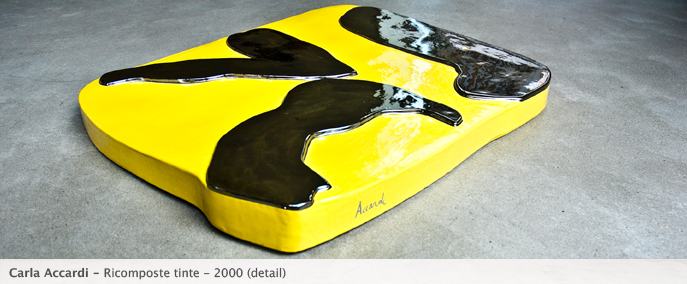

Bio
Cara Accardi
Trapani (Italy) 1924 – Rome, 2014
The systematic research and magnification of sign-color characterize since more than half a century the artistic personality of Carla Accardi, considered one of the greatest exponents of Italian Abstractism.
Carla Accardi trained as a painter at the Academy of Fine Arts in Florence, before moving to Rome in 1946.
Accardi quickly became part of the inner circle of the Art Club and was a frequent visitor to Pietro Consagra’s studio. There she met the artists with whom she would establish the influential postwar group Forma 1 (Form 1, 1947–51): Consagra, Piero Dorazio, Mino Guerrini, Achille Perilli, Antonio Sanfilippo (whom she would marry), and Giulio Turcato. The group’s manifesto, which Accardi signed in 1947, called for reconciling Marxist politics with abstract art. The group’s first exhibition occurred in Rome in 1947, and Accardi’s first solo show soon followed, in 1950 at the Galleria Age d’or, Rome. Her early paintings consisted of interlocking geometric forms.
In the 1950s, Accardi was involved in the wide-reaching attempts to revolutionize abstraction through the hybridization of geometric abstraction and gestural painting, both in Italy, where she appeared in Arte astratta e concreta in Italia—1951 (Abstract and concrete art in Italy—1951) at the Galleria nazionale d’arte moderna, Rome, and in France, where art critic Michel Tapié took an interest in her work. (Tapié would later write the introduction to the catalogue accompanying Accardi’s 1959 solo exhibition at the Galleria Notizie in Turin.) After forswearing painting from 1952 to 1953, Accardi began to introduce pseudo-calligraphic signs into abstract images, as in Labirinto a settori (Labyrinths and fields, 1957), while reducing her palette to white-on-black compositions to explore the relationship between figure and ground.
In 1961 Accardi reintegrated color and began painting on sicofoil, a transparent plastic, instead of canvas. She showcased these new strategies at the 1964 Venice Biennale. By the mid-1960s, she was using these new materials sculpturally. Tenda (Tent, 1965) and Triplice Tenda (Triple tent, 1969) feature sheets of plastic assembled into a tent and covered with brightly colored brushstroke patterns. This phase of Accardi’s oeuvre, which was celebrated in the Ambiente/Arte section of the 1976 Venice Biennale, would prove influential for Arte Povera. In the 1980s she returned to canvas and shifted her focus to the use of signs and chromatic juxtapositions.
Important exhibitions around the world consecrate the mediterranean-soaked energy of her work: from the ARC in Paris to the MACRO in Rome, from the MoMMa in Moscow to the Recoleta Centre in Buenos Aires and the Puglisi Cosentino Foundation in Catania. Recent solo exhibitions include CARLA ACCARDI, Palazzo Esposizioni, Roma, (2024); CARLA ACCARDI. The Seventies: Lenzuoli, Museo Correr, Venice (2023); Carla Accardi. Contesti, Museo del Novecento, Milan (2020); Omaggio a Carla Accardi, MACRO, Rome (2015). His most recent group exhibitions include Un tiempo propio. Librarse de las ataduras de lo cotidiano, Centre Pompidou Malaga (2022); Elles font l’abstraction, Centre Pompidou, Paris (2021); Senzamargine. Passaggi nell’arte italiana a cavallo del millennio, MAXXI Arte, Rome (2020); Donne. Corpo e immagine tra simbolo e rivoluzione, Galleria D’Arte Moderna, Rome (2019); Tutto. Prospettiva sull’arte italiana, MUSEION, Bolzano (2018).
A protagonist of major international events, we recall her participation in the 59th – 45th – 46th – 43rd – 37th – 32nd – 24th Venice Biennale (2022; 1993; 1995; 1988; 1978; 1964, 1948); Biennale de l’Havane, CU (2000).
Her works can be found in public and private collections around the world, including Solomon R. Guggenheim Museum, New York; Castello di Rivoli Museo d’Arte Contemporanea, Turin, IT; MUSEION, Bolzano, IT; MACRO Mueo d’Arte Contemporanea Rome; Peggy Guggenheim Collection, Venice; Museo Del Novecento, Milan; Museo d’Arte Moderna e Contemporanea di Trento e Rovereto (MART), Rovereto, IT; MAMbo – Galleria d’Arte Moderna di Bologna, Bologna, IT; Stedelijk Museum voor Actuele Kunst (S. M.A.K.), Ghent, BE; FRAC – Nord-Pas de Calais, Dunkirk, FR; Musée d’Art Moderne et Contemporain (MAMCS), Strasbourg, FR; Metropolitan Art Society (MAS), Beirut, LB; Museu de Arte Moderna Murilo Mendes, Juiz de Fora, BR.
Accardi died on February 23, 2014, in Rome.

